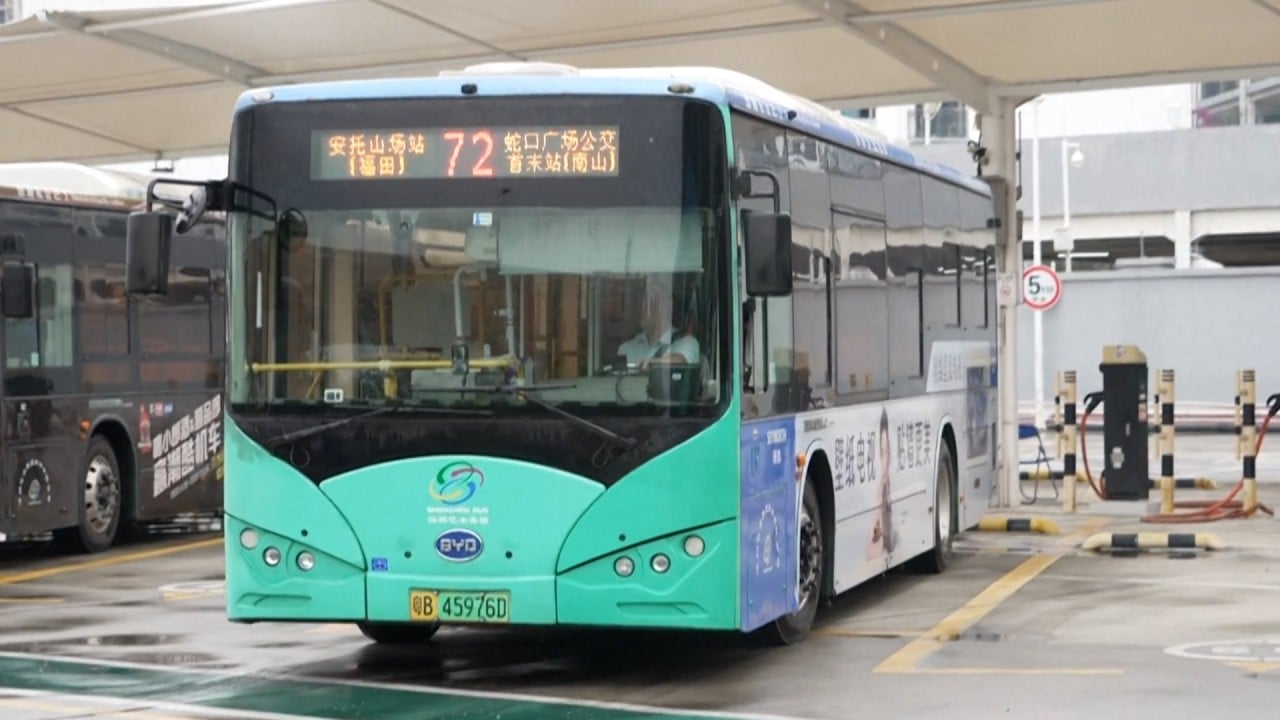Power is power: how newer, greener currents are sparking China’s energy reform – South China Morning Post
Backflow in a power grid occurs when electricity moves in the opposite direction of what is typical – in this case, from the consumer to the distribution network – as energy generated by household solar panels exceeds local consumption. If left unmanaged, it could lead to voltage fluctuations or blackouts in the worst cases.
Analysts have recommended a thoroughgoing reform of the power sector to resolve these issues, including the introduction of market-based mechanisms. They have issued a call for shareholders who can cover the costs associated with the widespread adoption of renewables.
And while the subject has come up frequently over the past decade, they said, the pace of reform has been slow.
Significantly, the delegate who spoke first at the symposium was the director of the State Power Investment Corporation.
The Chinese stock market reacted strongly to the news, with investors snapping up shares of companies producing solar panels and power storage equipment.
We need to be patient. This reform will not be finished overnight
“This is a sign the top leadership is still pushing for reform of the power sector,” said Yan Qin, Norway-based lead analyst at the London Stock Exchange Group.
The choice of first speaker was likely thought through carefully, she added, as the company has a high renewables share in its power generation business and is seen as a pioneer firm in the country’s green transition.
“However, even if this topic was brought up at the symposium, it does not necessarily mean the power sector reform will be sped up. It is a comprehensive process and needs solid steps,” Qin said.
“We need to be patient. This reform will not be finished overnight.”
The response was near-instantaneous. From 2021 to 2023, China’s average annual newly installed wind power capacity was 53.62 gigawatts, up 70.7 per cent from the previous five-year average.
During the same period, China’s average new solar installation totalled 119.45 gigawatts per year – an increase of 188 per cent compared with the figure for 2016 through 2020 according to Darius Tang, associate director of corporates at Fitch Bohua.
As of 2023, photovoltaic and wind have become China’s second- and third-largest power sources respectively, trailing only thermal power, Tang said.
But the substitution rate for new energy in the overall power supply has been slow, and thermal remains the backbone of China’s electricity grid.
In 2023, the share of thermal power was 69.9 per cent, only decreasing by 1.3 percentage points compared to 2020. The shares of wind and solar power were 9.1 per cent and 3.3 per cent last year, respectively, Tang added – 3.5 and 1.4 percentage points higher than 2020.
“It is impossible to ensure all the power generated by wind and solar can be consumed by the grid due to safety considerations,” Tang said. “This would result in an increase in wind and solar abandonment.”
Both are weather-dependent and prone to mismatches between supply and demand caused by time and space. Peak consuming hours come at night, and the population is heavily skewed toward the coast, but wind and solar energy are more abundant during daytime hours and in the country’s more spacious inland regions.
“In the past, people thought that as long as a solar or wind farm was constructed, it would be able to generate electricity,” said Lin Boqiang, dean of Xiamen University’s China Institute for Studies in Energy Policy. “But that is not the reality. You may not be able to generate power after installation because of stability issues, and there is a cost to achieve stability.”
That means additional infrastructure, like storage facilities and extra power grids. Without those, Lin said, even an infinite number of solar farms could do little more than bask in the sun.
“The speed of building power grids is difficult to keep up with the growth of new energy sources, just like the speed of road construction compared with the growth of vehicles,” he said.
On June 4, China’s National Energy Administration (NEA) issued a notice laying out a plan to escalate the integration of renewables in the power system. The first of its kind since 2018, the document advised constructing more grids, adding more flexible sources and establishing more reasonable requirements for utilisation.
In electricity grids, the curtailment rate refers to the percentage of energy that is permitted to be lost by the slowing or shutting down of a system to relieve congestion.
A nationally unified power market would allow more renewable generation … and would move China more quickly away from coal-fired power
“It signals the near-term challenge of grid capacity to accommodate growing intermittent renewables and the necessity of flexible resource development,” said Peng Chengyao, director for Greater China power and renewables at S&P Global Commodity Insights.
“Strengthening interprovincial and cross-regional power adjustment” was mentioned several times in the NEA’s notice, a persistent challenge in the reform of the country’s power sector.
“One area of focus is [constructing] a nationally unified power market,” said Herbert Crowther, energy analyst at Eurasia Group.
China’s power market has traditionally been regional, with each administrative area seeking to control most of its electricity generation and consumption. This creates a risk of overreliance on local – often coal-fired – power generation, Crowther added.
“Facilitating more effective interprovincial electricity trading under a nationally unified power market would allow more renewable generation from northern and western provinces to meet coastal electricity demand, and would move China more quickly away from coal-fired power,” he said.
Zhang Jianhua, the director of the NEA, published a column last month in China Electric Power News – a periodical affiliated with the administration. “As a high proportion of renewable energy and grid equipment are connected to the power system in large quantities,” he said, “the system’s anti-disturbance capability is on a downward trend. These changes have put forward higher requirements for our ability to manage the power system.”
“Given increasing electricity demand, it is critical for China to reform the power system to sustainably lower wind and solar curtailment rates, increase zero-emissions power plant utilisation rates, reform the energy trading system and improve grid connectivity ….to decouple from the need for thermal power as a backup resource to ensure energy security,” said Dong of the Sydney-based think tank.
In a response to questions from the Post, Du Zhongming, director general of the Department of Electricity of the National Energy Administration, elaborated on the state of the country’s new energy buildout during a June 20 press conference.
“This year, we are striving for the launch of 33 key projects, including the Sichuan-Chongqing 1,000-kilovolt ultra-high-voltage (UHV) alternating current project and the Qinghai Hongqi 750kV power transmission and transformation project,” Du said.
“[We are] starting construction on 37 others – including the Shaanxi-Anhui UHV direct current (DC) project and the Gansu-Zhejiang UHV DC project – to provide strong support for the consumption of new energy. By 2025, the distribution network will have a distributed new energy access capacity of about 500 million kilowatts.”
“No one wants to pay the bill,” said Lin of Xiamen University. “In the past, when the share of renewables was not that high, the government could ask [state-owned] power grid companies to buy them all. But they can no longer afford it.”
Inevitably, some of the power generated by renewable energy can flow nowhere but the market – and its instability makes it a hard sell.
“To increase the renewable energy supply significantly as a mixture of total energy output, it has to be reliable and predictable,” said Evan Li, head of Asia energy transition research at HSBC. “It has to be equipped with proper energy storage systems, and that investment is expensive without a proper revenue model, especially when wind and solar farms are being forced to price their power in the market.”
This is the major difference, he added, between China and developed markets, where there are long-term power purchase agreements that could provide more sustainable revenue streams for utilities – specifically renewables.
In some European countries and US states, such certificates are issued and traded in compliance markets because of government policies which require suppliers to have a certain percentage of renewable production in their supply portfolio.
“Green certificates have been widely mentioned by the [Chinese] government in the last six or seven years, but implementation has been a problem,” Li said.
Another possible path is passing down increased costs to end users through price liberalisation, making society pay for the environmental benefit of lower emissions.
In China, even if the price doesn’t rise, power companies will still need to provide electricity
“All we’ve really talked about at this point when it comes to market pricing for utilities – we do agree if prices for residential, water, gas and electricity should go up, they would go up,” Li added.
But increasing utility prices, especially for residential use, can be much more controversial in a country like China, where maintaining social stability is a perpetual priority.
“When it comes to market reform for the power sector, successful experience from other countries may not work for China,” Lin said. “The power grids in China are state-owned and have a natural monopoly. How can they be fully marketised?
“In places like the US, power suppliers can refuse to generate electricity if the price doesn’t rise. But in China, even if the price doesn’t rise, power companies will still need to provide electricity.”



